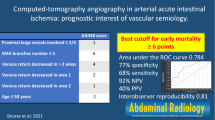Abstract
Background
Non-occlusive mesenteric ischemia (NOMI) is a mesenteric ischemic disease with considerably high mortality rate, although little has been known about what factors affect the patients’ prognosis. The purpose of this study was to investigate prognostic factors of clinical data and computed tomography (CT) findings in patients with NOMI.
Methods
This was a single institutional, retrospective study, reviewing 21 consecutive patients diagnosed with NOMI on angiography. Patients were divided into either ‘‘survivor’’ group or ‘‘non-survivor’’ group based on their clinical courses 1 month after diagnosis. Clinical information such as laboratory data, Charlson Comorbidity Index, and time from CT to injecting vasodilator was obtained from patients’ medical records. Contrast-enhanced CT images were assessed in following items: defect of mural enhancement, pneumatosis intestinalis, hepatic portal venous gas, paralytic bowel dilatation, bowel wall thinning, and diameters of the relevant vessels.
Results
Eight patients belonged to ‘‘survivor’’ group, whereas eleven were allocated to ‘‘non-survivor’’ group. None of CT findings showed significant difference between survivor group and non-survivor group [defect of mural enhancement: 75% and 100% (p = 0.16), pneumatosis intestinalis: 50% and 45.5% (p = 1.00), hepatic portal venous gas: 37.5% and 45.5% (p = 1.00), paralytic bowel dilatation: 12.5% and 63.6% (p = 0.06), and bowel wall thinning: 50% and 45.5% (p = 1.00)]. The diameters of the relevant vessels did not have significant difference either. Time from CT to injecting vasodilator was revealed to be significantly shorter in survivor group [187.5 (122.5–294) min and 310 (187–925.5)] (p = 0.048). None of the other clinical information had significant difference between each group.
Conclusion
Prompt angiography may be a key to improve the prognosis of NOMI patients.
Similar content being viewed by others
References
Ende N (1958) Infarction of the bowel in cardiac failure. N Engl J Med. https://doi.org/10.1056/NEJM195805012581804
Clair DG, Beach JM (2016) Mesenteric ischemia. N Engl J Med 374(1):959–968. https://doi.org/10.1056/NEJMra1503884
Lim JY, Kim JB, Jung SH et al (2017) Risk factor analysis for nonocclusive mesenteric ischemia following cardiac surgery. Medicine (United States). https://doi.org/10.1097/MD.0000000000008029
Siegelman SS, Sprayregen S, Boley SJ (1974) Angiographic diagnosis of mesenteric arterial vasoconstriction. Radiology. https://doi.org/10.1148/112.3.533
Woodhams R, Nishimaki H, Fujii K et al (2010) Usefulness of multidetector-row CT (MDCT) for the diagnosis of non-occlusive mesenteric ischemia (NOMI): assessment of morphology and diameter of the superior mesenteric artery (SMA) on multi-planar reconstructed (MPR) images. Eur J Radiol. https://doi.org/10.1016/j.ejrad.2009.05.012
Kammerer S, Schuelke C, Berkemeyer S et al (2018) The role of multislice computed tomography (MSCT) angiography in the diagnosis and therapy of non-occlusive mesenteric ischemia (NOMI): could MSCT replace DSA in diagnosis? PLoS ONE. https://doi.org/10.1371/journal.pone.0193698
Nakamura Y, Urashima M, Toyota N et al (2013) Non-occlusive mesenteric ischemia (NOMI): utility of measuring the diameters of the superior mesenteric artery and superior mesenteric vein at multidetector CT. Jpn J Radiol. https://doi.org/10.1007/s11604-013-0245-1
Kurimoto Y, Morishita K, Fukada J et al (2004) A simple but useful method of screening for mesenteric ischemia secondary to acute aortic dissection. Surgery. https://doi.org/10.1016/j.surg.2003.12.019
Frenkel WJ, Jongerius EJ, Mandjes-Van Uitert MJ et al (2014) Validation of the Charlson Comorbidity Index in acutely hospitalized elderly adults: a prospective cohort study. J Am Geriatr Soc. https://doi.org/10.1111/jgs.12635
Studer P, Vaucher A, Candinas D et al (2015) The value of serial serum lactate measurements in predicting the extent of ischemic bowel and outcome of patients suffering acute mesenteric ischemia. J Gastrointest Surg 19(4):751–755. https://doi.org/10.1007/s11605-015-2752-0
Locke GR, Pemberton JH, Phillips SF (2000) American Gastroenterological Association medical position statement: guidelines on intestinal ischemia. Gastroenterology 118(5):951–953. https://doi.org/10.1053/gg.2000.7030
Nakao S, Watanabe H, Takahashi Y et al (2011) Effectiveness of emergency laparotomy for diagnosis and treatment of severe non-occlusive mesenteric ischemia (NOMI). J Abdom Emerg Med 31(7):1021–1027. https://doi.org/10.11231/jaem.31.1021
Acknowledgements
The authors are grateful to Jay Starkey, M.D. for the revision of the English text.
Funding
The institutional review board exemption was granted for this study.
Author information
Authors and Affiliations
Corresponding author
Ethics declarations
Disclosures
Drs. Ryo Miyazawa and Minobu Kamo have no conflict of interest or financial ties to disclose.
Additional information
Publisher's Note
Springer Nature remains neutral with regard to jurisdictional claims in published maps and institutional affiliations.
Rights and permissions
About this article
Cite this article
Miyazawa, R., Kamo, M. What affects the prognosis of NOMI patients? Analysis of clinical data and CT findings. Surg Endosc 34, 5327–5330 (2020). https://doi.org/10.1007/s00464-019-07321-9
Received:
Accepted:
Published:
Issue Date:
DOI: https://doi.org/10.1007/s00464-019-07321-9




